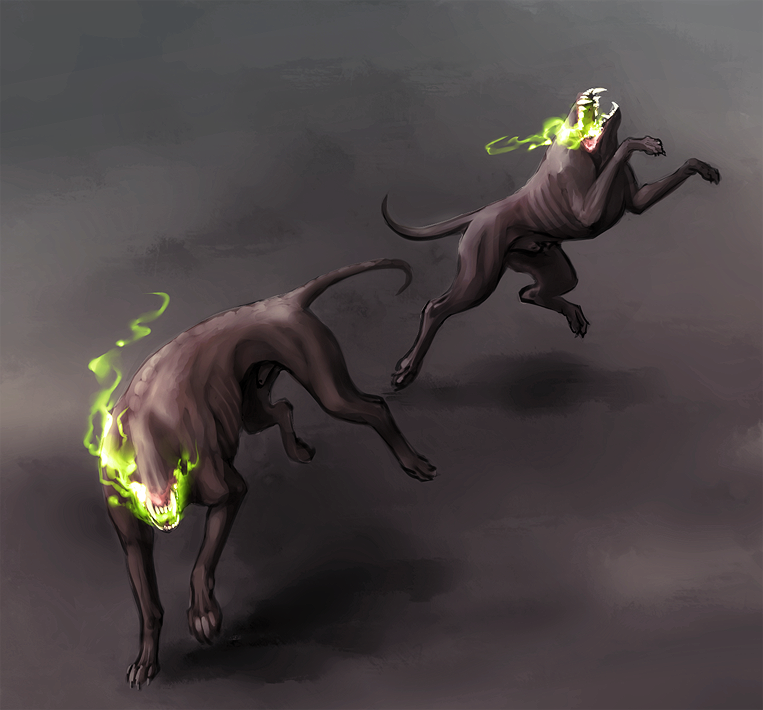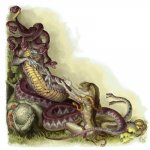Today we move onto the Yuan-Ti, starting with the
Yuan-Ti: Anathema. This is the top-tier entry for this race, much as a Warlord or Archmage is for humans, and it is an immortal power-hungry giant snake. What’s not to love?
Goodness me, the Anathema had a weird design in previous editions. This time around, they have changed it to be a Hydra-ti; it gets six heads, a huge constrictor snake body, and two humanoid arms. It’s a picture that manages to get the alien physiology looking plausible, with nice texturing and a pretty interesting grey/orange colour palate. It’s certainly a very well done picture, especially considering how easy it would be to mess up this creature design.
The Yuan-ti are a really fun race. Whereas the Hobgoblins are the organised evil guys with armies - the Cold War Russians, perhaps, or the French to your players’ English - the Yuan-ti are a little more subtle. They are pretty similar to the Drow in some ways - hide in remote places, like a certain type of animal, go in for assassination, illegal trade, and slavery, while they dream of world domination - there are enough differences to keep the two races very distinct. The Yuan-ti, as presented in Volo’s, are basically the bad guys who try to punch above their weight. Unable to field enough numbers to wage open war against all of humanoid civilisation, they resort to skulking around in their jungles and sending out skilled infiltrators to try and manipulate humanoid society to their benefit. The race’s narrative strengths lend themselves to a wide variety of plots - an
Indiana Jones raid on a temple complex in the jungle, finding and destroying a narcotics distribution network in the sewers, discovering why the king has suddenly become very erratic and making poor decisions - with some interesting and fairly unique visual aesthetics to back it all up. Even in D&D, fighting your way up a ziggurat in a jungle as snakes the size of men fire poisoned arrows at you is pretty much only going to happen against Yuan-ti.
The race gets several variants for you to use. Time for another quick table!
Yuan-ti Pureblood (CR 1, MM 310)
Yuan-ti Broodguard (CR 2, VGtM 203
Yuan-ti Malison (CR 3, MM 309
Yuan-ti Mind Whisperer (CR 4, VGtM 204)
Yuan-ti Nightmare Speaker (CR 4, VGtM 205)
Yuan-ti Pit Master (CR 5, VGtM 206)
Yuan-ti Abomination (CR 7, MM 308)
Yuan-ti Anathema (CR 12, VGtM 202)
Of these, the Pureblood is the infiltrator; the Broodguard and Malisons are standard brute enemies, with the Malisons being more dangerous at range; the Mind Whisperer, Nightmare Speaker, and Pit Master are priestly types, one for each of the main Yuan-ti gods; the Abomination and Anathema are leader types. Chapter one of Volo’s, which includes a lengthy description of Yuan-ti society and history, as well as some great imagery, lists just about everything imaginable as servants of the Yuan-ti: medusae, undead, constructs, NPC statblocks, animals, the whole works. This variety is probably down to the fact that the Yuan-ti are a highly intelligent and learned culture, which makes good use of arcane and divine magic to bring others under their control.
So let’s look at the Anathema, the top-tier entry for this race. It’s CR 12, the same as an Archmage, so we should interpret this as effectively the most powerful that a Yuan-ti can ‘naturally’ be, short of the gods (or the plot, more importantly) creating a monstrously powerful one to fight against the players. The Anathema is what happens when an Abomination, in search of divinity, uses a special ritual to get a step closer. The Yuan-ti gods are apparently pretty replaceable, and the top ranks of Yuan-ti society spend a lot of time trying to work out ways to absorb and supplant their gods. That sounds exhausting, and also suggests why the Yuan-ti might make mistakes or fail in their schemes, making it easier to write plot for a race of extremely smart and patient schemers. Anyway, the Anathema is divine
enough to become immortal, and gets some potent abilities that showcase what a snakegod gets up to.
The first of these is the spellcasting, which includes the level 7 Cleric spell
Divine Word, a spell that is very cool but not actually all that great; it’s more of a finisher than something which will let you win the fight. It will allow the Anathema to make a hell of an entrance though, if it slithers in and uses that on a room full of NPCs. It also gets some very solid spells -
Polymorph and
Haste are both spells that can dramatically change how this creature goes about its business, especially if you pre-cast the Polymorph to effectively double the length of the fight. On top of this, we get a
Ophidiophobia Aura, which lets it try to Frighten enemies nearby; it’s a passive that triggers when something starts it’s turn within 30ft. It’s a tough save, and an even tougher word to pronounce, and could make the party Rogue or Fighter very unhappy, though remember that Paladins are probably going to be immune to it by the time that they fight one of these.
The Anathema is also a pretty tough enemy, with decent AC, high HP, and a whole bevy of resistances, including to magic and the
stunned condition, the latter of which comes from having so many heads, like the Ettin. It’s saves are no higher than +4 to anything though, so even with advantage it is unlikely to save all that many spells. Like all Yuan-ti, the Anathema can change into a snake, a feature that is more fun than useful I think. More exciting is the melee abilities of this guy; apart from the limited spellcasting, you’re only going to do damage in melee here, but the Anathema makes up for that with 40ft move and some seriously damaging attacks. It has four attacks in its combat routine; two
Claws, each for 2d6, a
Flurry of Bites, for 10d6 on one poor fellow, and
Constrict to do 5d6 damage immediately, then at the start of a creature’s turns thereafter.
Overall, the Anathema is a
Huge snake that will rush into melee and toss dozens of D6 of damage at the party. It’s a great big bruiser of a leader, one who focuses on ripping its opponents apart, which is faintly surprising for a poison-and-intrigue themed race like the Yuan-ti, but upon reflection the Yuan-ti statblocks really tend towards being bruisers with some intrigue-related magic on top. (If you’re keen on a magical element, you can also easily use the new Yuan-ti PC race to easily reflavour some of the NPC statblocks.) Disappointingly, we don’t get any Lair or Legendary actions here, despite this being a perfect candidate for campaign-ending bad guy, so I would certainly suggest that you create some. Otherwise, I’m pretty happy with the Anathema as a bad guy, and I think that, with appropriate swarms of Abominations and Malisons, it’ll be an effective and memorable BBEG.






